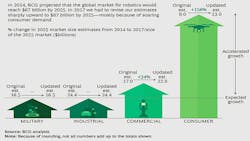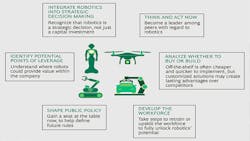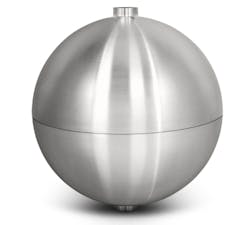Tech Notes is a weekly collection of news, notes, facts, figures, short stories, blurbs and more about the manufacturing tech world, published most Wednesdays here on IW.com. Have something you think should be shared? Send an email to [email protected] or tweet @MattLaWell.
Another week, another hearty endorsement for the strength of the global robot market. In its latest robotics report, released Wednesday, Boston Consulting Group projected the global spend for the market will hit $87 billion by 2025 — close to a 30% increase over the $67 billion BCG projected just three years ago.
Much of that increase is thanks to a burgeoning consumer market (up from a $9 billion projection in 2014 to $23 billion this time around), but more money will be poured into robots for the industrial space ($24.4 billion) than any other.
“Beyond helping to craft policy for robots that operate in public spaces, companies should participate in setting safety requirements at work, especially as cobots become more prevalent,” wrote the report’s five authors — Mel Wolfgang, Vlad Lukic, Alison Sander, Joe Martin and Daniel Kupper. “As robots become safer, the certification process — particularly in Europe — should become quicker and less onerous, encouraging further development in the field of automation.”
The report turns to some anecdotal information about Kiva and Amazon, Foxconn and Apple, and Nike, and at just six pages, it’s worth a quick break or lunch read.
How to capitalize on robots? Here are a handful of ways. / BCG
AUTODESK TAPS NEW CEO: After four months and changes of what appeared to be an out-of-the-blue transition, Autodesk has its new CEO. Andrew Anagnost, who has worked for the company for the last 20 years and was co-CEO along with Amar Hanspal since February, assumed the position Monday. He is also the company’s new president.
Anagnost succeeds Carl Bass, who first joined Autodesk in 1993, stepped away from 2001 to 2003, and was the company’s CEO from 2006 until February 7, one day after he described Donald Trump as “acting somewhere between a dictator and a small business owner” in an interview with Pando. Autodesk said it had been developing a succession plan for 18 months, but the timing seemed at least curious.
In a letter to employees published Monday, Anagnost wrote: “The next era of Autodesk is not defined by product or business innovation — but in their combination. We must excel at both, all in the service of our customers. To ensure their success, and ours, we will improve not only our product experience, but also our customer experience. And we will continue to deliver incredible tools that customers can use to make a better world.”
ADDITIVE HIGHLIGHTS PARIS AIR SHOW: The Paris Air Show is normally a stage for the latest, greatest planes, with the normal names — Airbus, Boeing, Gulfstream, Lockheed Martin, etc. — hogging the headlines. This year, Sciaky is trying to steal some of the attention by introducing its Electron Beam Additive Manufacturing tech, which produces large-scale, high-value metal parts, while reducing material waste and machining time, and operating with a shorter time-to-market. Production time is cut from months to days.
Sciaky VP Bob Phillips said the EBAM tech will continue “helping push additive manufacturing into the mainstream,” and it’s hard to argue the point.
Sciaky is a subsidiary of Phillips Service Industries and is headquartered in Chicago. The Paris Air Show runs through Sunday.
A titanium propulsion tank, 16 inches in diameter. New parts could be
50 inches in diameter. / Lockheed Martin
NEW EQUIPMENT OF THE WEEK: Kickstarter has helped to introduce us to the Coolest Cooler, rekindled Veronica Mars and Reading Rainbow, and, of course, put Pebbles on hundreds of thousands of wrists. The Dagoma NEVA 3-D printer might soon be among the more notable crowdfunded projects on the site.
The NEVA is designed for personal use, not industrial. So what separates it from any number of other home 3-D printers? Its price, for starters (billed at $299, but $349 right now on Kickstarter), plus its self-calibrating design, its ability to be put to use right out of the box, and its ease of use (press one button and you’re good to go). We’re all for increased use of the tech, and a new machine like this can’t hurt. If you want one, make sure to back it now: funding ends at noon Eastern on Thursday.
OTHER NEW GADGETS: Swiss robotics makers ABB introduced its ACS380 machinery drive last week, which “offers EMC and connectivity variants for ease of integration and connectivity” for machine builders. It is designed to include automation and motor control. … And Dutch vehicle maker PAL-V opened their new production facility last month in the Netherlands. Sounds like a Comings, Goings item, right? Normally, sure … until you hear what PAL-V makes: flying cars. Granted, they’re not road-safe (or air-safe, for that matter), but this is definitely a gadget, right? We’ll keep our eyes on this one.
STRATASYS GOES SUPERSONIC (ALMOST): Additive leader Stratasys and Boom Supersonic announced a technical partnership last week that they say could bring commercial air travel closer to routine supersonic speeds. It is, of course, based on accelerated production of advanced tooling and production-grade aircraft parts based on Stratasys FDM 3-D printing tech.
Stratasys also introduced its new Fortus 900mc Aircraft Interiors Certification Solution, which includes hardware and software designed exclusively for 3-D printing aircraft parts with repeatable mechanical properties. It aims to remove complexity from FAA and EASA certification.
COMINGS, GOINGS and MONEY MATTERS: Dassault Systèmes acquired a majority stake in cloud services company Outscale. The transaction will allow Dassault to “adjust and control its cloud resources and services to manage peaks in activity, further diversify its industry segments, deploy new features, and provide advanced on premise, private and hybrid cloud solutions for its 3DEXPERIENCE platform customers.” … Industrial IT solutions provider Hexagon announced plans last week to invest about 90 million Euros ($100.3 million) in a new Chinese production facility. The facility will be located in Huangdao, right on the Yellow Sea coast and about 430 miles southeast of Beijing, and measure about 560,000 square feet. … IIoT sensor systems company Samsara announced $40 million in Series C funding, led by General Catalyst, with participation by Andreessen Horowitz. Samsara is now valued around $530 million. … Augury, an IIoT tech company that analyzes data and catches malfunctions before they’re actually malfunctions, closed a $17 million round of Series B funding led by Eclipse Ventures and the venture arms of Hartford Steam Boiler. … SoftWear Automation, which I wrote about last year, received $4.5 million in funding from CTW Venture Partners to accelerate development of fully-automated sewn goods worklines designed specifically for apparel production. (Your tailor won’t be pushed out of business just yet, but maybe don’t encourage your kids to get into that business.)
Andrew Farah, a man who wants you to be able to work in your car ...
or something like that. / Chuck Cloud
QUOTE OF THE WEEK: “We’re closer than most people think. I’ve been riding around in them now for almost a year, and the first rides weren’t so good. But the rides these days are as good as some people I know when they drive. …I sit in the back seat.” — Andrew Farah, who describes himself as chief technology architect for autonomous vehicles for GM, during an interview last week on NPR’s Wait Wait … Don’t Tell Me!
Because Farah worked on the Chevy Volt, host Peter Sagal asked him three questions about Chevy Chase (medium talent), because why not? But they also briefly discussed autonomous cars in an intelligent and approachable manner for most folks. It was a pleasant surprise to hear talk about the tech — including range anxiety, wire cutting and the special “dad package” — dropped right in the middle of the long-running quiz show. If you have 10 minutes somewhere in your day, give it a listen.
About the Author
Matt LaWell
Staff Writer
Staff writer Matt LaWell explores news in manufacturing technology, covering the trends and developments in automation, robotics, digital tools and emerging technologies. He also reports on the best practices of the most successful high tech companies, including computer, electronics, and industrial machinery and equipment manufacturers.
Matt joined IndustryWeek in 2015 after six years at newspapers and magazines in West Virginia, North Carolina and Ohio, a season on the road with his wife writing about America and minor league baseball, and three years running a small business. He received his bachelor's degree in magazine journalism from Ohio University.



